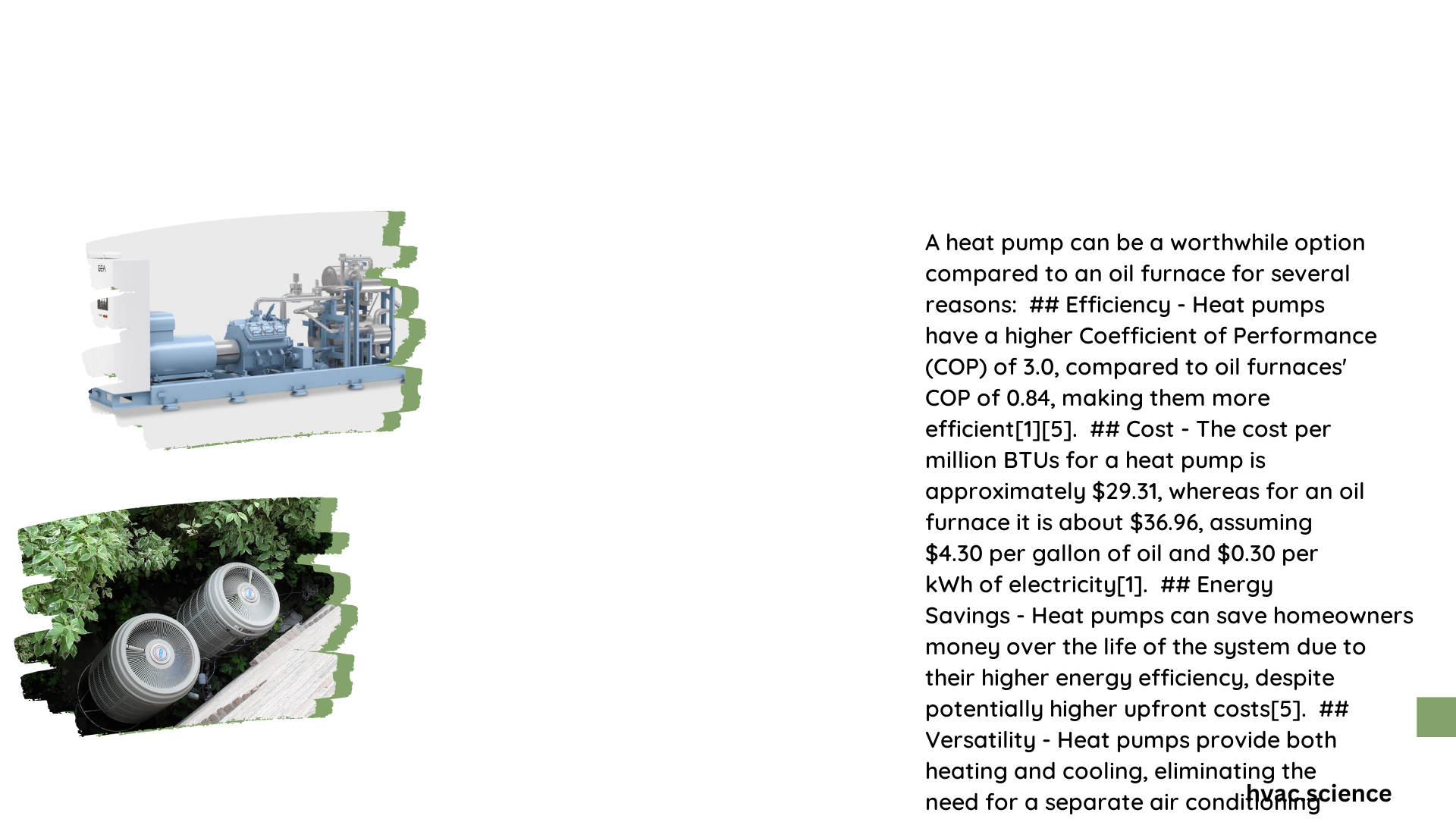When considering home heating options, many homeowners find themselves weighing the benefits of a heat pump against their existing oil furnace. This decision involves comparing initial costs, long-term savings, efficiency, and performance in various climate conditions. Heat pumps offer potential energy savings and versatility, while oil furnaces provide reliable heating in colder climates. The choice between the two depends on factors such as local energy prices, climate, and individual home characteristics.
What Are the Cost Implications of Choosing a Heat Pump Over an Oil Furnace?
Initial Investment
The upfront costs for heat pumps and oil furnaces differ significantly:
- Heat Pump Installation:
- Range: $6,000 to $16,000
- Can go up to $26,000 for complex installations
-
Factors: Home size, number of units needed
-
Oil Furnace Installation:
- Range: $6,400 to $9,200
- Average cost: $7,400
Heat pumps generally have a higher initial cost, but this can vary based on specific requirements and local factors.
Operational Costs
Heat pumps typically offer lower operational costs:
- Annual savings with heat pumps: Approximately $500 compared to combustion-based systems
- For a 2,000-square-foot home: Potential annual savings of $846 when switching from fuel oil to a heat pump (assuming $5 per gallon of fuel oil)
Oil furnaces have higher operational costs due to fluctuating oil prices:
- Average oil consumption: 6.5 gallons per day at 32°F
- Typical 275-gallon tank requires monthly refills
Long-term Savings
Over a 10-year period, heat pumps can provide substantial savings:
- Potential 10-year savings: $8,460 (based on annual savings of $846)
- Payback period: 2 to 7 years, considering installation costs and potential rebates
Maintenance Expenses
Both systems require similar maintenance:
- Annual HVAC technician inspection
- Air filter replacement every six months
How Do Heat Pumps and Oil Furnaces Compare in Efficiency?

Heat Pump Efficiency
Heat pumps boast impressive efficiency ratings:
- Coefficient of Performance (COP): 300% or higher
- Heating Seasonal Performance Factor (HSPF): 8 to 12
- Seasonal Energy Efficiency Ratio (SEER): 14 to 20 or higher for efficient models
Efficiency decreases in colder temperatures but remains higher than oil furnaces in most conditions.
Oil Furnace Efficiency
Oil furnaces offer consistent efficiency:
- Average efficiency: 85%
- Efficiency remains stable regardless of outdoor temperature
What Are the Differences in Installation Processes?
Heat Pump Installation
- More complex and potentially expensive
- May require new ductwork or electrical upgrades
- Installation time: Several days to a week or more
- Cost range: $6,000 to $16,000 or higher
Oil Furnace Installation
- Generally simpler and less expensive
- Often fits existing ductwork
- May require modifications for oil tank
- Installation time: Typically a few days
- Cost range: $6,400 to $9,200
How Do These Systems Perform in Different Climate Conditions?
Heat Pump Performance
- Most effective above freezing temperatures
- Efficient operation down to around 32°F (0°C)
- Efficiency decreases in colder temperatures
- Some models include auxiliary heating for very cold conditions
- Provides both heating and cooling capabilities
Oil Furnace Performance
- Consistent heat output regardless of outdoor temperature
- Particularly effective in very cold climates
- Delivers heat through hot air ducts or radiators/baseboards
- Higher quality heat in very cold conditions compared to heat pumps
What Factors Should Homeowners Consider When Deciding Between a Heat Pump and an Oil Furnace?
- Local Climate:
- Heat pumps are more suitable for moderate climates
-
Oil furnaces perform better in extremely cold regions
-
Energy Prices:
- Compare local electricity rates vs. oil prices
-
Consider potential future price fluctuations
-
Home Insulation:
- Well-insulated homes benefit more from heat pumps
-
Poorly insulated homes may require the higher heat output of oil furnaces
-
Environmental Concerns:
- Heat pumps have lower carbon emissions
-
Oil furnaces burn fossil fuels, contributing to higher emissions
-
Existing Infrastructure:
- Homes with existing ductwork may find oil furnaces easier to install
-
Homes without ductwork might benefit from ductless heat pump systems
-
Long-term Plans:
- Consider how long you plan to stay in the home
- Factor in potential energy price changes and technology improvements
What Are the Pros and Cons of Each System?
Heat Pump Pros and Cons
Pros:
– Higher energy efficiency
– Lower operational costs
– Provides both heating and cooling
– Environmentally friendly
Cons:
– Higher upfront costs
– Reduced efficiency in very cold temperatures
– May require backup heating in extreme cold
Oil Furnace Pros and Cons
Pros:
– Lower initial installation cost
– Consistent heat output in all temperatures
– Effective in very cold climates
Cons:
– Higher operational costs
– Reliance on volatile oil prices
– Higher carbon emissions
– Requires oil storage and regular refills
Conclusion
Determining whether a heat pump is worth it when compared to an oil furnace depends on various factors including local climate, energy prices, home characteristics, and personal preferences. Heat pumps offer significant long-term savings and environmental benefits, especially in moderate climates. However, oil furnaces remain a reliable option for very cold regions or homes with existing oil heating infrastructure. Homeowners should carefully consider their specific situation, consult with HVAC professionals, and potentially conduct an energy audit before making a decision.
References:
1. Heat pumps vs. oil furnace heating: What’s better in 2024?
2. Heat Pumps Vs. Oil Heating: Pros And Cons
3. Cost of Oil or Gas Heat Vs Heat Pump
